-

新人教版高中英语必修2Unit 1 Cultural Heritage-Discovering Useful Structure教案一
This teaching period mainly deals with grammar “restrictive relative clauses.” To begin with, teachers should lead students to revise what they have learned about the relative pronouns and relative adverbs. And then, teachers move on to stress more special cases concerning this grammar, such as the “preposition+ relative pronouns which and whom” and cases where we can omit the relative pronouns. This period carries considerable significance to the cultivation of students’ writing competence and lays a solid foundation for the basic appreciation of language beauty. The teacher is expected to enable students to master this period thoroughly and consolidate the knowledge by doing some exercises. 1. Guide students to review the basic usages of relative pronouns and adverbs of attributive clauses.2. Lead students to learn to use some special cases concerning restrictive relative clauses flexibly.2. Enable students to use the basic phrases structures flexibly.3. Strengthen students’ great interest in grammar learning.1. Help students to appreciate the function of relative pronouns and adverbs of attributive clauses in a sentence2. Instruct students to write essays using the proper relative pronouns and adverbs of attributive clauses.本节语法思考:定语从句在复合句中的作用是什么? 关系词有哪些?定语从句在复合句中的作用相当于形容词,它在句中作定语修饰名词或代词。他们在先行词和定语从句之间起到联系作用,同时在意义上代表先行词并在定语从句中担任一个成分。被定语从句所修饰的词称先行词,定语从句一般放在先行词的后面。

新人教版高中英语必修2Unit 1 Cultural Heritage-Reading and Thinking教案二
1. This section focuses on "Understanding how a problem was solved”, which is aimed to guide students to analyze and discuss the challenges and problems faced by cultural heritage protection during the construction of Aswan Dam, as well as the solutions. On the basis of understanding, students should pay attention to the key role of international cooperation in solving problems, and attach importance to the balance and coordination between cultural heritage protection and social and economic development. Students are encouraged to face challenges actively, be good at cooperation, and make continuous efforts to find reasonable ways and means to solve problems.2. Enable students to understand the main information and text structure of the reading text;3. Motivate students to use the reading strategy "make a timeline" according to the appropriate text genre;4. Enable students to understand how a problem was solved;5. Enable students to understand the value of protecting cultural heritage by teamwork and global community;1. Guide students to pay attention to reading strategies, such as prediction, self-questioning and scanning.2. Help students sort out the topic language about protecting cultural relics and understand the narrative characteristics of "time-event" in illustrative style3. Lead students to understand the value of protecting cultural heritage by teamwork and global community;

新人教版高中英语必修2Unit 1 Cultural Heritage-Reading and Thinking教案一
The theme of the reading and thinking is about “Understanding how a problem was solved”.The Listening & Speaking & Talking is about international co-work to protect the Mount Tai, in which the students from seven countries came up with many solutions even create the Mount Tai App. This section aims at showing how to solve a difficult and even tough problem about protecting the cultural heritage by the international co-work. So in this section, cultivating students’ international awareness is very clear and important. Concretely, with the economic development, how to balance the protection of cultural relics and social development is a big challenge for human. In the 1950s, the Egyptian government wanted to build the Aswan Dam across the Nile to control floods, produce electricity and water farms. But the proposal led to protests because it would destroy a lot of cultural relics. The Egyptian had no choice but ask the UN for help. Therefore, a international cooperation about how to protect the cultural relics began, which involved the time length about 20 years and a large amount of fund. Then, the problems was solved. 1. Read quickly to get the main idea and the structure of the article; read careful to get detailed information.2. Learn to use the reading strategy---making a timeline3. Learn how to solve a tough problem by asking for help and cooperation4. Have the international awareness and understand the great strength of international cooperation.1. Read quickly to get the main idea and the structure of the article; read careful to get detailed information.2. Learn to use the reading strategy---making a timeline.3. Learn how to solve a tough problem by asking for help and cooperation.

新人教版高中英语必修2Unit 4 History and Traditions-Listening&Speaking&Talking教案一
This unit is about history and traditions. From the opening page, we can know that this unit will introduce the history and traditions around the world. As Marcus Garvey says “A people without the knowledge of their past history, origin and culture is like a tree without roots”, it is important for students to realize the importance and value of knowing the history and traditions and their further meanings. And this part ( listening and speaking ) is divided into two parts: Part A---share views on historic sites, Part B ---talk about a visit to a historic tourist destination. By talking with a foreigner, the speakers introduce the historic attractions and their cultures. Part A is that William, a British student, who was going to visit the Confucius Temple and a Chinese student, Xiao Kong, who was going to the Confucius Temple to meet with the members of the research group, went together and exchanged their views on the Confucius Temple, Confucius, Confucius' descendants and Confucius' educational thoughts. Part B is a conversation between Xiao Yan, a youth hostel receptionist and Paul, a backpacker about the feelings and experience after visiting the Chinese famous tourist attraction Pingyao.1. Guide students to understand the content of listening texts in terms of the whole and key details; 2. Cultivate students' ability to guess the meaning of words in listening; discuss with their peers how to talk about historic spots and great person.3. Instruct students to use functional sentences of showing one’s excitement, surprise and disappointment.1. Guide students to understand the content of listening texts in terms of the whole and key details; 2. Cultivate students' ability to discuss with their peers the related topics.3. Enable students to use the functional items of showing one’s excitement, surprise and disappointment.

新人教版高中英语必修2Unit 5 Music-Listening&Speaking&Talking教案
choir memberspeople to run food stands people to sell festival ticketspeople to sell music CDspeople to set up equipmentmusical performersStep 2: Listen to the announcement again and answer the questions. ? 1. What kind of songs will Grace Davis sing at the festival?? 2. Who can try out as a performer?? 3. What can those who think they do not have musical talent do?? 4. How can students volunteer to take part?? Talking about preferences:? Would you prefer doing ..?? What would you prefer to do?? Would you rather do .... or ….?? What would you rather do?? I'd prefer .... to ..? I'd rather have ... than .. Step 3: Speaking ProjectWork in groups. Role-play the conversation or make a new one.? Debbie: Where have you been? You missed the announcement about the music festival.? John: I was at the doctor's office. Music festival?? Frank: Yes, it's going to be next month on the school sports field. John, you can play the piano. How about playing it at the festival?? John: Well, I'd rather play the violin. I can play Liang Zhu.? Frank: Wow! Sounds good. What about you, Debbie? ? Debbie: Actually, I don't have much musical ability. I'd prefer just to help out with the crowds.? Frank: You can sell tickets or work at a food stand.? John: So can I assume that the aim of the festival is to raise money?? Debbie: Yes. All of the money will go to charity.

新人教版高中英语选修4Unit 2 Iconic Attractions教案
帮助学生通过讨论与对主题的提升,反思自己的旅游方式,以便做出更优化的安排,在今后的旅程中有更多的收益。 Activity 2: Further discussion of the 6 elements above and supplement of more background knowledge 本活动为实现课时教学目标2。 1.Target Q: The writer’s clear target of traveling, meeting the people and experiencing the culture, is closely related to his major in social studies. Then what is social studies? Social studies is a part of a school or college curriculum concerned with the study of social relationships and the functioning of society and usually made up of courses in history, government, economics, civics, sociology, geography, and anthropology. (Dictionary by Merriam-Webster) Reflection: When you go out to travel, what targets do you usually have in mind? 2.Research Q: Suppose you are traveling to Hangzhou during the school holidays, how will you do research on the city? (surf the internet, read books or travel brochures, consult friends, ...) What information will you be interested to know? (location, iconic sites, local cuisines, interesting customs, shopping malls ...) 3.Abandonment To make the most of time, we have to learn to abandon so that we can accomplish our plan. What will you be interested in doing if you go to Hangzhou if you have a week’s time? What if you only have 2 days? 4~5. Venturing & Experiencing Q: What did he venture to do during the trip? What new experiences did he have? In Sydney: attend his first open-air barbecue, enjoy many different but yummy meals In Catherine: observe the life and customs of the aborigines appreciate their music & try the musical instruments: the didgeridoo

部编人教版五年级上册《猎人海力布》说课稿
一、教材分析《猎人海力布》是一则在内蒙古自治区流传的民间故事,故事描写了善良、诚实的海力布,为了拯救乡亲们的生命,不惜自己变成一块石头。人们因此世世代代纪念他。这则故事虽然篇幅较长,但语言通俗易懂,围绕海力布“舍己救乡亲”的中心事件,层层铺垫,寓理寓情于故事中,给人强烈的感染和教育。本单元的训练重点是简要复述课文。从教材本身看,本课有以下特点:一是课题表明写人;二是情节生动,语言通俗易懂;三是想象力奇特丰富。二、教学目标分析要学生简要复述课文,首先要让学生熟悉课文内容,理清课文脉络,因此第一个教学目标定位为熟悉课文,了解事件的起因、经过、结果。要学生复述好课文,可以借助列小标题的方法理解课文内容、理清层次、找出要点。除了熟悉课文内容外,还要理解把握理解课文内容及把握人物的品质,因此,第二个目标定位品读课文,感悟人物的形象、品质。第三目标定位简要复述故事,并初步学习将人物对话改成一般叙述的方法。
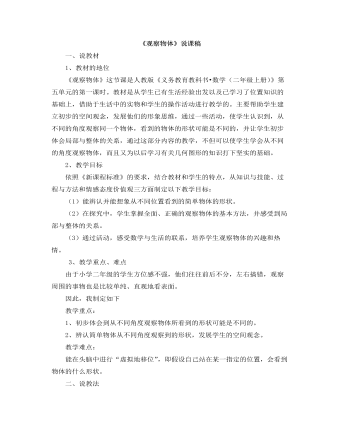
小学数学人教版二年级上册《观察物体》说课稿
1、教材的地位《观察物体》这节课是人教版《义务教育教科书?数学(二年级上册)》第五单元的第一课时。教材是从学生已有生活经验出发以及已学习了位置知识的基础上,借助于生活中的实物和学生的操作活动进行教学的。主要帮助学生建立初步的空间观念,发展他们的形象思维,通过一些活动,使学生认识到,从不同的角度观察同一个物体,看到的物体的形状可能是不同的,并让学生初步体会局部与整体的关系,通过这部分内容的教学,不但可以使学生学会从不同的角度观察物体,而且又为以后学习有关几何图形的知识打下坚实的基础。 2、教学目标依照《新课程标准》的要求,结合教材和学生的特点,从知识与技能、过程与方法和情感态度价值观三方面制定以下教学目标:(1)能辨认并能想象从不同位置看到的简单物体的形状。 (2)在探究中,学生掌握全面、正确的观察物体的基本方法,并感受到局部与整体的关系。 (3)通过活动,感受数学与生活的联系,培养学生观察物体的兴趣和热情。3、教学重点、难点由于小学二年级的学生方位感不强,他们往往前后不分,左右搞错,观察周围的事物也是比较单纯、直观地看表面。

小学数学人教版五年级上册《小数乘小数》说课稿
一、说教材小数乘以小数的原有基础是整数乘整数、小数乘整数。它为小数除法、小数四则混合运算和分数小数四则混合运算学习奠定基础,占据着重要的地位。小数乘小数是五年级上册第一单元小数乘法的难点和关键,一共涉及三个知识点,1.确定积小数点位置;2.积位数不够时添“0”补足;3.小数连乘的探究。第一课时是根据整数乘法算出积后来确定积的小数点位置,不涉及积位数不够时用0来补足的知识。本课时的关键在于理解算理,归纳算法。根据以上的分析及新课程标准的要求,考虑到学生已有的认知结构,对整数乘法算理的掌握,能对小数乘整数积小数点的定位,制定以下的教学目标:知识与能力:共同探讨,理解并掌握小数乘小数的算理及算法;过程与方法:在探索过程中,培养学生观察、比较、归纳与概括的能力和用数学语言进行表述交流的能力,渗透转化思想;
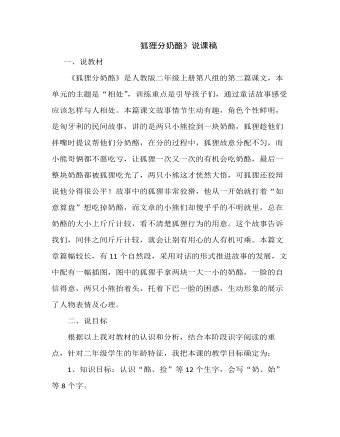
部编人教版二年级上册《狐狸分奶酪》说课稿
二、说目标根据以上我对教材的认识和分析,结合本阶段识字阅读的重点,针对二年级学生的年龄特征,我把本课的教学目标确定为:1、知识目标:认识“酪、捡”等12个生字,会写“奶、始”等8个字。2、语感目标:正确流利有感情地朗读课文,会分角色读课文。3、能力目标:读懂故事内容,能对狐狸的说法作出判断,初步表达自己的想法。三、重难点在确定教学目标后,我把本科划分为两个课时,本次说课的内容为第二课时,其教学重点是理解课文内容、分角色读课文,对狐狸的说法作出判断,初步表达自己的想法。四、说教法、学法。先学后教、以学定教、会的不教。上课前一天下发本课前置小研究,课前检查学生的预习情况,当堂解决孩子们困惑的地方,或者我认为学生需要了解并掌握的知识进行巩固教学,课堂上的教学方法,以小组合作,展示交流为主。
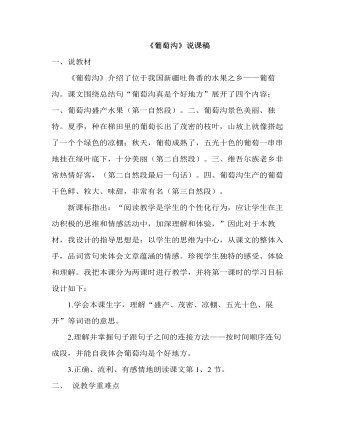
部编人教版二年级上册《葡萄沟》说课稿
三、说教法 :以读为本,读中感悟 阅读教学以读为本,是由阅读教学的基本任务所决定的。阅读教学的基本任务是培养独立阅读的能力和养成良好的阅读习惯,而完成上述基本任务的基本途径是学生自己的读书实践。读可以显形,读可以激趣,可以动情,可以启智,可以育人。因此在本课时的阅读教学中我设计了各种形式的读,让学生充分地读,在读中整体感知,在读中有所感悟,在读中培养语感,在读中受到情感的熏陶,让学生在琅琅书声中益知、怡情,发展语言和能力。四、说学法 :自主学习 合作探究 新课程导引的新课堂,其本质特征在于学生真正成为课堂教学的主体,是实践主体、认识主体,又是道德主体、审美主体。一句话,他们应当是自主发展、自我构建的主体。而活动是主体存在和发展的方式。离开了自主的、具体的、感性的学习活动,学生是无法获得主体地位,也不能发挥主体作用的。因此在本节课的教学设计中,我尽可能地给学生自主学习的机会,自主选择学习内容,自主选择朗读方式,自主选择作业方式,自读自悟,自己观察发现……让学生真正成为学习的主人。
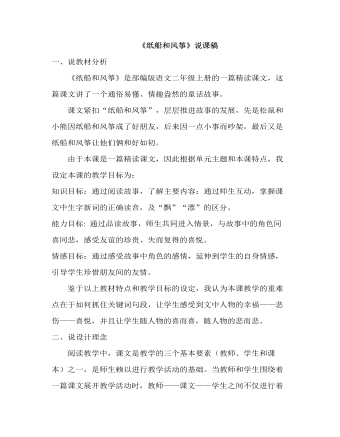
部编人教版二年级上册《纸船和风筝》说课稿
一、说教材分析《纸船和风筝》是部编版语文二年级上册的一篇精读课文,这篇课文讲了一个通俗易懂、情趣盎然的童话故事。课文紧扣“纸船和风筝”,层层推进故事的发展,先是松鼠和小熊因纸船和风筝成了好朋友,后来因一点小事而吵架,最后又是纸船和风筝让他们俩和好如初。由于本课是一篇精读课文,因此根据单元主题和本课特点,我设定本课的教学目标为:知识目标:通过阅读故事,了解主要内容:通过师生互动,掌握课文中生字新词的正确读音,及“飘”“漂”的区分。能力目标: 通过品读故事,师生共同进入情景,与故事中的角色同喜同悲,感受友谊的珍贵、失而复得的喜悦。情感目标:通过感受故事中角色的感情,延伸到学生的自身情感,引导学生珍惜朋友间的友情。鉴于以上教材特点和教学目标的设定,我认为本课教学的重难点在于如何抓住关键词句段,让学生感受到文中人物的幸福——悲伤——喜悦,并且让学生随人物的喜而喜,随人物的悲而悲。
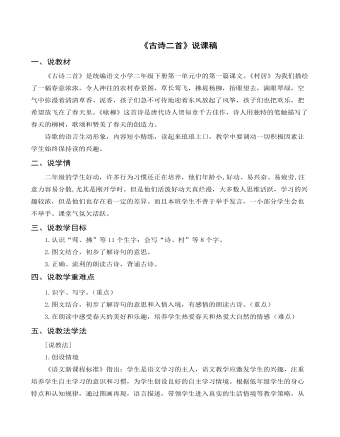
(说课稿) 《古诗二首》部编人教版二年级上册
二、说学情?? 二年级的学生好动,许多行为习惯还正在培养,他们年龄小,好动、易兴奋、易疲劳,注意力容易分散,尤其是刚开学时。但是他们活泼好动天真烂漫,大多数人思维活跃,学习的兴趣较浓,但是他们也存在着一定的差异。而且本班学生不善于举手发言,一小部分学生会也不举手。课堂气氛欠活跃。三、说教学目标1.认识“莺、拂”等11个生字;会写“诗、村”等8个字。2.图文结合,初步了解诗句的意思。3.正确、流利的朗读古诗,背诵古诗。四、说教学重难点1.识字、写字。(重点)2.图文结合,初步了解诗句的意思和入情入境,有感情的朗读古诗。(重点)3.在朗读中感受春天的美好和乐趣,培养学生热爱春天和热爱大自然的情感(难点)
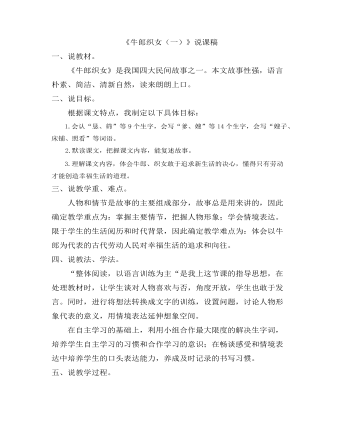
部编人教版五年级上册《牛郎织女(一)》 说课稿
三、说教学重、难点。人物和情节是故事的主要组成部分,故事总是用来讲的,因此确定教学重点为:掌握主要情节,把握人物形象;学会情境表达。限于学生的生活阅历和时代背景,因此确定教学难点为:体会以牛郎为代表的古代劳动人民对幸福生活的追求和向往。四、说教法、学法。“整体阅读,以语言训练为主“是我上这节课的指导思想,在处理教材时,让学生谈对人物喜欢与否,角度开放,学生也敢于发言。同时,进行将想法转换成文字的训练,设置问题,讨论人物形象代表的意义,用情境表达延伸想象空间。
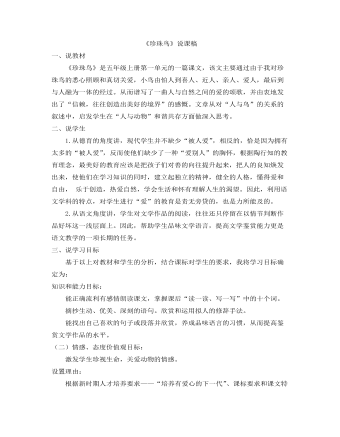
部编人教版五年级上册《 珍珠鸟》说课稿
二、说学生 1.从德育的角度讲,现代学生并不缺少“被人爱”,相反的,恰是因为拥有太多的“被人爱”,反而使他们缺少了一种“爱别人”的胸怀,根据陶行知的教育理念,最美好的教育应该是把孩子们对善的向往提升起来,把人的良知焕发出来,使他们在学习知识的同时,建立起独立的精神,健全的人格,懂得爱和自由, 乐于创造,热爱自然,学会生活和怀有理解人生的渴望。因此,利用语文学科的特点,对学生进行“爱”的教育是责无旁贷的,也是力所能及的。2.从语文角度讲,学生对文学作品的阅读,往往还只停留在以情节判断作品好坏这一浅层面上。因此,帮助学生品味文学语言,提高文学鉴赏能力更是语文教学的一项长期的任务。
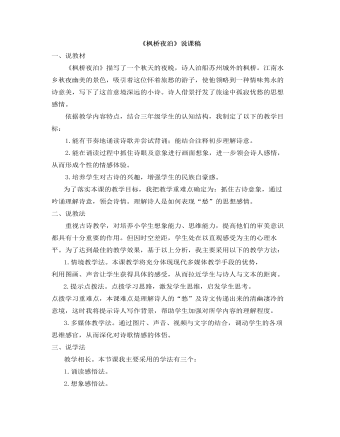
部编人教版五年级上册《古诗词三首-枫桥夜泊》说课稿
四、说教学过程依据以上分析,我做了如下的教学流程设计:谈话导入:我们从上一节课中了解了出门远行的杜牧在山间对枫叶的热爱。而今天,江南秋夜,桥畔孤舟,常年的羁旅生涯,使诗人张继对水乡静谧幽美的景色有着更深的感受,顿时绵绵诗意流注笔端,写下了这首千古绝唱《枫桥夜泊》。今天我们一起来欣赏。1.读,读出语感。先听老师范读,给学生一个初体验。然后让学生对照注音、注释读,解决字音词义的问题,再听录音跟读,检查自己诵读时在字音上是否正确。因为已学的《山行》也是七言绝句,学生已做过划分七言绝句节奏的练习,所以在读准字音的基础上再让学生边读边划句子节奏,然后请个别学生诵读,大家评议节奏划分是否正确。这个环节主要体现了学生的自主学习。
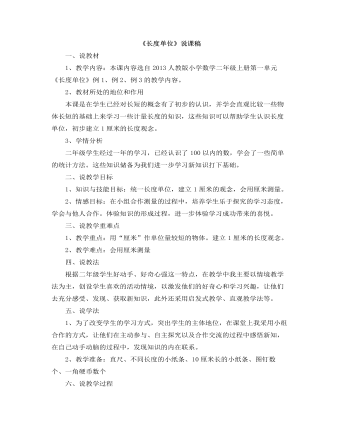
小学数学人教版二年级上册《长度单位》说课稿
一、说教材1、教学内容:本课内容选自2013人教版小学数学二年级上册第一单元《长度单位》例1、例2、例3的教学内容。 2、教材所处的地位和作用本课是在学生已经对长短的概念有了初步的认识,并学会直观比较一些物体长短的基础上来学习一些计量长度的知识,这些知识可以帮助学生认识长度单位,初步建立1厘米的长度观念。 3、学情分析二年级学生经过一年的学习,已经认识了100以内的数,学会了一些简单的统计方法。这些知识储备为我们进一步学习新知识打下基础。二、说教学目标1、知识与技能目标:统一长度单位,建立1厘米的观念,会用厘米测量。2、情感目标:在小组合作测量的过程中,培养学生乐于探究的学习态度,学会与他人合作。体验知识的形成过程,进一步体验学习成功带来的喜悦。
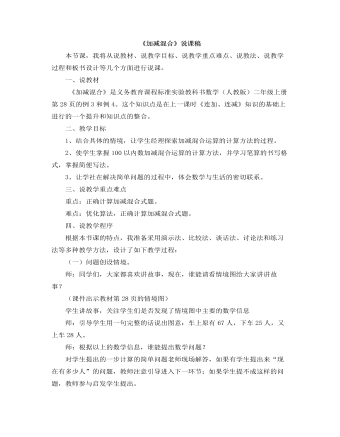
小学数学人教版二年级上册《加减混合》说课稿
一、说教材《加减混合》是义务教育课程标准实验教科书数学(人教版)二年级上册第28页的例3和例4。这个知识点是在上一课时《连加、连减》知识的基础上进行的一个提升和知识点的整合。二、教学目标 1、结合具体的情境,让学生经理探索加减混合运算的计算方法的过程。 2、使学生掌握100以内数加减混合运算的计算方法,并学习笔算的书写格式,掌握简便写法。 3、让学社在解决简单问题的过程中,体会数学与生活的密切联系。三、说教学重点难点重点:正确计算加减混合式题。 难点:优化算法,正确计算加减混合式题。 四、说教学程序 根据本节课的特点,我准备采用演示法、比较法、谈话法、讨论法和练习法等多种教学方法,设计了如下教学过程:
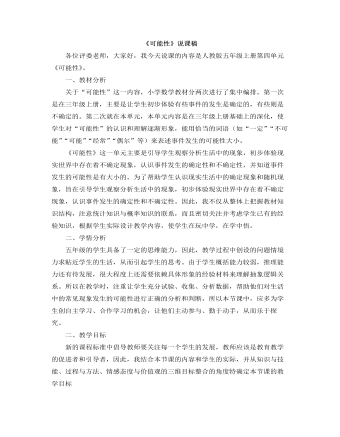
小学数学人教版五年级上册《可能性》说课稿
二、学情分析五年级的学生具备了一定的思维能力,因此,教学过程中创设的问题情境力求贴近学生的生活,从而引起学生的思考。由于学生概括能力较弱,推理能力还有待发展,很大程度上还需要依赖具体形象的经验材料来理解抽象逻辑关系。所以在教学时,注重让学生充分试验、收集、分析数据,帮助他们对生活中的常见现象发生的可能性进行正确的分析和判断,所以本节课中,应多为学生创自主学习、合作学习的机会,让他们主动参与、勤于动手,从而乐于探究。二、教学目标新的课程标准中倡导教师要关注每一个学生的发展,教师应该是教育教学的促进者和引导者,因此,我结合本节课的内容和学生的实际,并从知识与技能、过程与方法、情感态度与价值观的三维目标整合的角度特确定本节课的教学目标 1.通过试验操作,懂得有些事情的发生是确定的,有些则是不确定的,并用“一定”“不可能”“可能”等词语来描述知道事情发生的可能性是有大有小的,且可能性的大小与物体数量有关。2.经历猜测、试验、收集与分析试验结果等过程。 3培养学生的随机观念以及培养学生判断、推理和合作探究的能力。
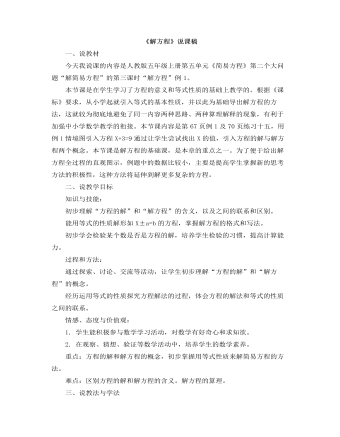
小学数学人教版五年级上册《解方程》说课稿
二、说教学目标知识与技能:初步理解“方程的解”和“解方程”的含义,以及之间的联系和区别。能用等式的性质解形如X±a=b的方程,掌握解方程的格式和写法。初步学会检验某个数是否是方程的解,培养学生检验的习惯,提高计算能力。过程和方法:通过探索、讨论、交流等活动,让学生初步理解“方程的解”和“解方程”的概念。经历运用等式的性质探究方程解法的过程,体会方程的解法和等式的性质之间的联系。情感、态度与价值观:1. 学生能积极参与数学学习活动,对数学有好奇心和求知欲。2. 在观察、猜想、验证等数学活动中,培养学生的数学素养。重点:方程的解和解方程的概念,初步掌握用等式性质来解简易方程的方法。难点:区别方程的解和解方程的含义。解方程的算理。三、说教法与学法教法:新课标指出,教师是学习的组织者、引导者、合作者,充分发挥学生的主体性。根据这一理念,我在教学中通过观察、猜想、验证等方式,自主探索、自主学习。有目的地运用知识迁移的规律,引导学生进行观察、比较、分析、概括,培养学生的逻辑思维能力。学法:①让学生学会以旧引新,掌握并运用知识迁移进行学习的方法;②让学生学会自主发现问题,分析问题,解决问题的方法。

